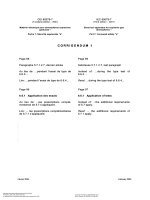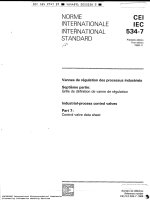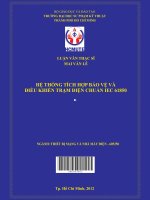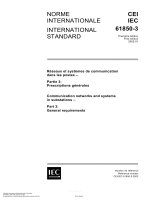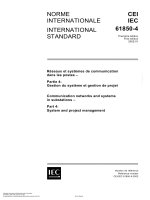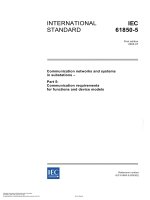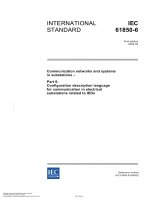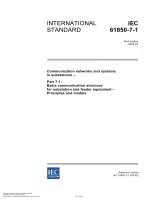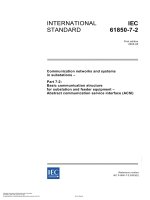IEC-61850-7-4
Bạn đang xem bản rút gọn của tài liệu. Xem và tải ngay bản đầy đủ của tài liệu tại đây (1.1 MB, 110 trang )
INTERNATIONAL
STANDARD
IEC
61850-7-4
First edition
2003-05
Communication networks and systems
in substations –
Part 7-4:
Basic communication structure for substation
and feeder equipment – Compatible logical node
classes and data classes
--``````-`-`,,`,,`,`,,`---
Reference number
IEC 61850-7-4:2003(E)
Copyright International Electrotechnical Commission
Provided by IHS under license with IEC
No reproduction or networking permitted without license from IHS
Not for Resale
Publication numbering
As from 1 January 1997 all IEC publications are issued with a designation in the
60000 series. For example, IEC 34-1 is now referred to as IEC 60034-1.
Consolidated editions
The IEC is now publishing consolidated versions of its publications. For example,
edition numbers 1.0, 1.1 and 1.2 refer, respectively, to the base publication, the
base publication incorporating amendment 1 and the base publication incorporating
amendments 1 and 2.
Further information on IEC publications
The technical content of IEC publications is kept under constant review by the IEC,
thus ensuring that the content reflects current technology. Information relating to
this publication, including its validity, is available in the IEC Catalogue of
publications (see below) in addition to new editions, amendments and corrigenda.
Information on the subjects under consideration and work in progress undertaken
by the technical committee which has prepared this publication, as well as the list
of publications issued, is also available from the following:
•
IEC Web Site (www.iec.ch)
•
Catalogue of IEC publications
The on-line catalogue on the IEC web site ( />enables you to search by a variety of criteria including text searches, technical
committees and date of publication. On-line information is also available on
recently issued publications, withdrawn and replaced publications, as well as
corrigenda.
•
IEC Just Published
This summary of recently issued publications ( />justpub/jp_entry.htm) is also available by email. Please contact the Customer
Service Centre (see below) for further information.
•
Customer Service Centre
If you have any questions regarding this publication or need further assistance,
please contact the Customer Service Centre:
Email:
Tel:
+41 22 919 02 11
Fax: +41 22 919 03 00
--``````-`-`,,`,,`,`,,`---
Copyright International Electrotechnical Commission
Provided by IHS under license with IEC
No reproduction or networking permitted without license from IHS
Not for Resale
INTERNATIONAL
STANDARD
IEC
61850-7-4
First edition
2003-05
Communication networks and systems
in substations –
--``````-`-`,,`,,`,`,,`---
Part 7-4:
Basic communication structure for substation
and feeder equipment – Compatible logical node
classes and data classes
IEC 2003 Copyright - all rights reserved
No part of this publication may be reproduced or utilized in any form or by any means, electronic or
mechanical, including photocopying and microfilm, without permission in writing from the publisher.
International Electrotechnical Commission, 3, rue de Varembé, PO Box 131, CH-1211 Geneva 20, Switzerland
Telephone: +41 22 919 02 11 Telefax: +41 22 919 03 00 E-mail: Web: www.iec.ch
Com mission Electrotechnique Internationale
International Electrotechnical Com m ission
Международная Электротехническая Комиссия
Copyright International Electrotechnical Commission
Provided by IHS under license with IEC
No reproduction or networking permitted without license from IHS
Not for Resale
PRICE CODE
XD
For price, see current catalogue
–2–
61850-7-4 IEC:2003(E)
CONTENTS
FOREWORD .......................................................................................................................... 6
INTRODUCTION .................................................................................................................... 8
--``````-`-`,,`,,`,`,,`---
1
Scope .............................................................................................................................. 9
2
Normative references ......................................................................................................10
3
Terms and definitions ......................................................................................................11
4
Abbreviated terms ...........................................................................................................11
5
Logical node classes .......................................................................................................15
5.1
5.2
5.3
5.4
Logical Node groups ..............................................................................................15
Interpretation of Logical Node tables ......................................................................16
System Logical NodesLN Group: L .........................................................................17
5.3.1 General......................................................................................................17
5.3.2 LN: Physical device informationName: LPHD ..............................................18
5.3.3 Common Logical Node ...............................................................................18
5.3.4 LN: Logical node zeroName: LLN0 .............................................................19
Logical Nodes for protection functionsLN Group: P .................................................19
5.4.1 Modelling remarks ......................................................................................19
5.4.2 LN: DifferentialName: PDIF ........................................................................21
5.4.3 LN: Direction comparisonName: PDIR ........................................................22
5.4.4 LN: DistanceName: PDIS ...........................................................................22
5.4.5 LN: Directional overpowerName: PDOP ......................................................23
5.4.6 LN: Directional underpowerName: PDUP ....................................................23
5.4.7 LN: Rate of change of frequencyName: PFRC ............................................24
5.4.8 LN: Harmonic restraintName: PHAR ...........................................................24
5.4.9 LN: Ground detectorName: PHIZ ................................................................25
5.4.10 LN: Instantaneous overcurrentName: PIOC ................................................25
5.4.11 LN: Motor restart inhibitionName: PMRI ......................................................25
5.4.12 LN: Motor starting time supervisionName: PMSS ........................................26
5.4.13 LN: Over power factorName: POPF ............................................................26
5.4.14 LN: Phase angle measuringName: PPAM ...................................................27
5.4.15 LN: Protection schemeName: PSCH...........................................................27
5.4.16 LN: Sensitive directional earthfaultName: PSDE .........................................28
5.4.17 LN: Transient earth faultName: PTEF .........................................................29
5.4.18 LN: Time overcurrentName: PTOC .............................................................29
5.4.19 LN: OverfrequencyName: PTOF .................................................................30
5.4.20 LN: OvervoltageName: PTOV .....................................................................30
5.4.21 LN: Protection trip conditioningName: PTRC...............................................30
5.4.22 LN: Thermal overloadName: PTTR .............................................................31
5.4.23 LN: UndercurrentName: PTUC ...................................................................32
5.4.24 LN: UndervoltageName: PTUV ...................................................................32
5.4.25 LN: Underpower factorName: PUPF ...........................................................33
5.4.26 LN: UnderfrequencyName: PTUF ...............................................................33
5.4.27 LN: Voltage controlled time overcurrentName: PVOC .................................34
5.4.28 LN: Volts per HzName: PVPH.....................................................................34
5.4.29 LN: Zero speed or underspeedName: PZSU ...............................................35
Copyright International Electrotechnical Commission
Provided by IHS under license with IEC
No reproduction or networking permitted without license from IHS
Not for Resale
61850-7-4 IEC:2003(E)
5.5
--``````-`-`,,`,,`,`,,`---
Logical
5.5.1
5.5.2
5.5.3
5.5.4
5.5.5
5.5.6
5.5.7
5.5.8
5.5.9
5.5.10
5.5.11
5.6 Logical
5.6.1
5.6.2
5.6.3
5.6.4
5.6.5
5.6.6
5.7 Logical
5.7.1
5.7.2
5.7.3
5.8 Logical
5.8.1
5.8.2
5.8.3
5.8.4
5.9 Logical
5.9.1
5.9.2
5.9.3
5.9.4
5.9.5
5.10 Logical
5.10.1
5.10.2
5.10.3
5.10.4
5.10.5
5.10.6
5.10.7
5.10.8
5.10.9
5.11 Logical
5.11.1
5.11.2
5.11.3
–3–
Nodes for protection related functionsLN Group: R .....................................35
Modelling Remarks ....................................................................................35
LN: Disturbance recorder functionName: RDRE..........................................36
LN: Disturbance recorder channel analogueName: RADR ...........................37
LN: Disturbance recorder channel binaryName: RBDR................................37
LN: Disturbance record handlingName: RDRS ............................................38
LN: Breaker failureName: RBRF .................................................................38
LN: Directional elementName: RDIR...........................................................38
LN: Fault locatorName: RFLO ....................................................................39
LN: Power swing detection/blockingName: RPSB .......................................39
LN: AutoreclosingName: RREC ..................................................................40
LN: Synchronism-check or synchronisingName: RSYN ...............................41
Nodes for controlLN Group: C ....................................................................42
Modelling remarks ......................................................................................42
LN: Alarm handlingName: CALH.................................................................42
LN: Cooling group controlName: CCGR ......................................................42
LN: InterlockingName: CILO .......................................................................43
LN: Point-on-wave switchingName: CPOW .................................................43
LN: Switch controllerName: CSWI ..............................................................44
nodes for generic referencesLN Group: G ..................................................44
LN: Generic automatic process controlName: GAPC...................................44
LN: Generic process I/OName: GGIO .........................................................45
LN: Generic security applicationName: GSAL .............................................45
Nodes for interfacing and archivingLN Group: I...........................................46
LN: ArchivingName: IARC ..........................................................................46
LN: Human machine interfaceName: IHMI ..................................................46
LN: Telecontrol interfaceName: ITCI...........................................................47
LN: Telemonitoring interfaceName: ITMI.....................................................47
Nodes for automatic controlLN Group: A.....................................................47
Modelling remarks ......................................................................................47
LN: Neutral current regulatorName: ANCR..................................................47
LN: Reactive power controlName: ARCO ....................................................48
LN: Automatic tap changer controllerName: ATCC......................................48
LN: Voltage controlName: AVCO ................................................................49
Nodes for metering and measurementLN Group: M ....................................50
Modelling remarks ......................................................................................50
LN: Differential measurementsName: MDIF ................................................50
LN: Harmonics or interharmonicsName: MHAI ............................................51
LN: Non phase related harmonics or interharmonicsName: MHAN ..............52
LN: MeteringName: MMTR .........................................................................54
LN: Non phase related MeasurementName: MMXN ....................................54
LN: MeasurementName: MMXU .................................................................55
LN: Sequence and imbalanceName: MSQI .................................................55
LN: Metering StatisticsName: MSTA ...........................................................56
Nodes for sensors and monitoringLN Group: S ...........................................57
Modelling remarks ......................................................................................57
LN: Monitoring and diagnostics for arcsName: SARC..................................57
LN: Insulation medium supervision (gas)Name: SIMG.................................57
Copyright International Electrotechnical Commission
Provided by IHS under license with IEC
No reproduction or networking permitted without license from IHS
Not for Resale
5.12
5.13
5.14
5.15
6
Data
61850-7-4 IEC:2003(E)
5.11.4 LN: Insulation medium supervision (liquid)Name: SIML ...............................58
5.11.5 LN: Monitoring and diagnostics for partial dischargesName: SPDC .............59
Logical Nodes for switchgearLN Group: X ..............................................................59
5.12.1 LN: Circuit breakerName: XCBR.................................................................59
5.12.2 LN: Circuit switchName: XSWI ...................................................................60
Logical Nodes for instrument transformersLN Group: T ..........................................60
5.13.1 LN: Current transformerName: TCTR .........................................................60
5.13.2 LN: Voltage transformerName: TVTR .........................................................61
Logical Nodes for power transformersLN Group: Y .................................................61
5.14.1 LN: Earth fault neutralizer (Petersen coil)Name: YEFN ...............................61
5.14.2 LN: Tap changerName: YLTC.....................................................................62
5.14.3 LN: Power shuntName: YPSH ....................................................................62
5.14.4 LN: Power transformerName: YPTR ...........................................................63
Logical Nodes for further power system equipmentLN Group: Z ..............................63
5.15.1 LN: Auxiliary networkName: ZAXN..............................................................63
5.15.2 LN: BatteryName: ZBAT .............................................................................64
5.15.3 LN: BushingName: ZBSH ...........................................................................64
5.15.4 LN: Power cableName: ZCAB .....................................................................65
5.15.5 LN: Capacitor bankName: ZCAP ................................................................65
5.15.6 LN: ConverterName: ZCON ........................................................................65
5.15.7 LN: GeneratorName: ZGEN........................................................................65
5.15.8 LN: Gas insulated lineName: ZGIL..............................................................66
5.15.9 LN: Power overhead lineName: ZLIN ..........................................................66
5.15.10 LN: MotorName: ZMOT ..............................................................................67
5.15.11 LN: ReactorName: ZREA............................................................................67
5.15.12 LN: Rotating reactive componentName: ZRRC ...........................................67
5.15.13 LN: Surge arrestorName: ZSAR .................................................................68
5.15.14 LN: Thyristor controlled frequency converterName: ZTCF ...........................68
5.15.15 LN: Thyristor controlled reactive componentName: ZTCR ...........................68
name semantics......................................................................................................69
Annex A (normative) Extension rules ....................................................................................91
A.1 The use of Logical Nodes and Data and its extensions ....................................................91
A.1.1 Basic rules .............................................................................................................91
A.2 Multiple instances of LN classes for dedicated and complex functions .............................91
A.2.1 Example for time overcurrent .................................................................................91
A.2.2 Example for Distance .............................................................................................91
A.2.3 Example for Power transformer ..............................................................................92
A.2.4 Example for Auxiliary network ................................................................................92
A.3 Specialisation of Data by use of the number extension ....................................................92
A.4 Rules for names of new Logical Nodes ............................................................................92
A.5 Examples for new LNs ....................................................................................................93
A.5.1 New LN “Automatic door entrance control” .............................................................93
A.5.2 New LN “Fire protection” ........................................................................................93
A.6 Rules for names of new Data ..........................................................................................93
A.7 Example for new Data .....................................................................................................93
A.8 Rules for new Common Data Classes (CDC) ...................................................................94
Copyright International Electrotechnical Commission
Provided by IHS under license with IEC
No reproduction or networking permitted without license from IHS
Not for Resale
--``````-`-`,,`,,`,`,,`---
–4–
61850-7-4 IEC:2003(E)
–5–
Annex B (informative) Modelling examples............................................................................95
B.1 PTEF and PSDE .............................................................................................................95
B.2 PSCH and PTRC.............................................................................................................96
B.3 MDIF and PDIF ...............................................................................................................97
B.4 RDRE and Disturbance Recorder ....................................................................................98
B.5 PTRC..............................................................................................................................99
B.6 PDIR 100
B.7 RREC ...........................................................................................................................101
Annex C (informative) Relationship between this standard and IEC 61850-5 .......................104
Figure 1 – Overview of this standard ......................................................................................10
Figure 2 – LN Relationships...................................................................................................17
Figure B.1 – Fault current I F in a compensated network with earth fault..................................95
Figure B.2 – Use of PSCH and PTRC ....................................................................................96
Figure B.3 – Use of MDIF and PDIF .......................................................................................97
Figure B.4 – Modelling of Disturbance Recorder ....................................................................98
Figure B.5 – Examples for allocation of Logical Nodes to IEDs ...............................................99
Figure B.6 – Use of PDIR ....................................................................................................100
Figure B.7 – Use of RREC ...................................................................................................101
Table 1 – List of Logical Node Groups ...................................................................................15
Table 2 – Interpretation of Logical Node tables ......................................................................16
Table 3 – Relation between IEC 61850-5 and IEC 61850-7-4 (this standard) for
protection LNs .......................................................................................................................20
Table 4 – Relation between IEC 61850-5 and IEC 61850-7-4 for protection related LNs .........35
Table 5 – Relation between IEC 61850-5 and IEC 61850-7-4 for control LNs ..........................42
Table 6 – Relation between IEC 61850-5 and IEC 61850-7-4 for automatic control LNs ..........47
Table 7 – Relation between IEC 61850-5 and IEC 61850-7-4 for metering and
measurement LNs .................................................................................................................50
Table 8 – Relation between IEC 61850-5 and IEC 61850-7-4 for sensors
and monitoring LNs ...............................................................................................................57
Table 9 – Description of Data ................................................................................................69
Table C.1 – Relationship between IEC 61850-5 and this standard for some
miscellaneous LNs ..............................................................................................................104
Copyright International Electrotechnical Commission
Provided by IHS under license with IEC
No reproduction or networking permitted without license from IHS
Not for Resale
--``````-`-`,,`,,`,`,,`---
B.8 PDIS 102
61850-7-4 IEC:2003(E)
–6–
INTERNATIONAL ELECTROTECHNICAL COMMISSION
___________
COMMUNICATION NETWORKS AND SYSTEMS IN SUBSTATIONS –
Part 7-4: Basic communication structure for substation
and feeder equipment – Compatible logical node classes
and data classes
FOREWORD
1) The IEC (International Electrotechnical Commission) is a worldwide organization for standardization comprising
all national electrotechnical committees (IEC National Committees). The object of the IEC is to promote
international co-operation on all questions concerning standardization in the electrical and electronic fields. To
this end and in addition to other activities, the IEC publishes International Standards. Their preparation is
entrusted to technical committees; any IEC National Committee interested in the subject dealt with may
participate in this preparatory work. International, governmental and non-governmental organizations liaising
with the IEC also participate in this preparation. The IEC collaborates closely with the International Organization
for Standardization (ISO) in accordance with conditions determined by agreement between the two
organizations.
2) The formal decisions or agreements of the IEC on technical matters express, as nearly as possible, an
international consensus of opinion on the relevant subjects since each technical committee has representation
from all interested National Committees.
3) The documents produced have the form of recommendations for international use and are published in the form
of standards, technical specifications, technical reports or guides and they are accepted by the National
Committees in that sense.
--``````-`-`,,`,,`,`,,`---
4) In order to promote international unification, IEC National Committees undertake to apply IEC International
Standards transparently to the maximum extent possible in their national and regional standards. Any
divergence between the IEC Standard and the corresponding national or regional standard shall be clearly
indicated in the latter.
5) The IEC provides no marking procedure to indicate its approval and cannot be rendered responsible for any
equipment declared to be in conformity with one of its standards.
6) Attention is drawn to the possibility that some of the elements of this International Standard may be the subject
of patent rights. The IEC shall not be held responsible for identifying any or all such patent rights.
International Standard IEC 61850-7-4 has been prepared by IEC technical committee 57:
Power system control and associated communications.
The text of this standard is based on the following documents:
FDIS
Report on voting
57/622/FDIS
57/640/RVD
Full information on the voting for the approval of this standard can be found in the report on
voting indicated in the above table.
This publication has been drafted in accordance with the ISO/IEC Directives, Part 2.
Copyright International Electrotechnical Commission
Provided by IHS under license with IEC
No reproduction or networking permitted without license from IHS
Not for Resale
61850-7-4 IEC:2003(E)
–7–
IEC 61850 consists of the following parts, under the general title Communication networks
and systems in substations:
Part 1:
Introduction and overview
Part 2:
Glossary 1
Part 3:
General requirements
Part 4:
System and project management
Part 5:
Communication requirements for functions and device models 2
Part 6:
Configuration description language for communication in electrical substations
1
related to IEDs
Part 7-1: Basic communication structure for substation and feeder equipment – Principles and
models
Part 7-2: Basic communication structure for substation and feeder equipment – Abstract
communication service interface (ACSI)
Part 7-3: Basic communication structure for substation and feeder equipment – Common data
classes
Part 7-4: Basic communication structure for substation and feeder equipment – Compatible
logical node classes and data classes
Part 8-1: Specific communication service mapping (SCSM) – Mappings to MMS (ISO/IEC
1
9506-1 and ISO/IEC 9506-2) and to ISO/IEC 8802-3
Part 9-1: Specific communication service mapping (SCSM) – Sampled values over serial
unidirectional multidrop point to point link
Part 9-2: Specific communication service mapping (SCSM) – Sampled values over ISO/IEC
1
8802-3
Part 10:
Conformance testing
1
The content of this part of IEC 61850 is based on existing or emerging standards and
applications. In particular the definitions are based upon:
•
the specific data types defined in IEC 60870-5-101 and IEC 60870-5-103;
•
the common class definitions from the Utility Communication Architecture 2.0: Generic
Object Models for Substation and Feeder Equipment (GOMSFE) (IEEE TR 1550);
•
CIGRE Report 34-03, Communication requirements in terms of data flow within substations,
December 1996.
The committee has decided that the contents of this publication will remain unchanged until 2005.
At this date, the publication will be
•
•
•
•
reconfirmed;
withdrawn;
replaced by a revised edition, or
amended.
___________
1 Under consideration.
2 To be published.
--``````-`-`,,`,,`,`,,`---
Copyright International Electrotechnical Commission
Provided by IHS under license with IEC
No reproduction or networking permitted without license from IHS
Not for Resale
61850-7-4 IEC:2003(E)
–8–
INTRODUCTION
This part of IEC 61850 is a part of set of specifications (IEC 61850). IEC 61850 defines a
substation communication architecture. This architecture has been chosen to provide abstract
definitions of classes and services such that the specifications are independent of specific
protocol stacks, implementations, and operating systems. The mapping of these abstract
classes and services to communication stacks is outside the scope of IEC 61850-7-x and may
be found in IEC 61850-8-x and in IEC 61850-9-x.
IEC 61850-7-1 gives an overview of this communication architecture. IEC 61850-7-3 defines
common attribute types and common data classes related to substation applications.
The attributes of the common data classes may be accessed using services defined
in IEC 61850-7-2. These common data classes are used in this part to define the compatible
data classes.
To reach interoperability, all data in the data model need a strong definition with regard to
syntax and semantics. The semantics of the data is mainly provided by names assigned to
logical nodes and data they contain, as defined in this part. Interoperability is easiest if as
much as possible of the data are defined as mandatory. Because of different philosophies and
technical features, settings were declared as optional in this edition of the standard. After some
experience has been gained with this standard, this decision may be reviewed in an
amendment or in the next revision of this part.
It should be noted that data with full semantics is only one of the elements required to achieve
interoperability. Since data and services are hosted by devices (IED), a proper device model is
needed along with compatible, domain specific services (see IEC 61850-7-2).
The compatible logical node name and data name definitions found in this part and the
associated semantics are fixed. The syntax of the type definitions of all data classes are
abstract definitions provided in IEC 61850-7-2 and IEC 61850-7-3. Not all features of logical
nodes are listed in this part for example data sets and logs are covered in IEC 61850-7-2.
--``````-`-`,,`,,`,`,,`---
Copyright International Electrotechnical Commission
Provided by IHS under license with IEC
No reproduction or networking permitted without license from IHS
Not for Resale
61850-7-4 IEC:2003(E)
–9–
COMMUNICATION NETWORKS AND SYSTEMS IN SUBSTATIONS –
Part 7-4: Basic communication structure for substation
and feeder equipment – Compatible logical node classes
and data classes
1
Scope
This part of IEC 61850 specifies the information model of devices and functions related to
substation applications. In particular, it specifies the compatible logical node names and data
names for communication between Intelligent Electronic Devices (IED). This includes the
relationship between Logical Nodes and Data.
To avoid private, incompatible extension rules this part specifies normative naming rules for
multiple instances and private extensions of Logical Node (LN) Classes and Data Names.
In Annex A, all rules are given (making use of examples) for:
•
multiple instances of logical node classes by use of a LN instance identification (ID);
•
multiple instances of data by use of a data instance ID;
•
selecting data not included in LN out of the complete data name set;
•
creating new logical node classes and data names.
In Annex B, examples are given for:
•
the use of Logical Nodes in complex situations like line protection schemes;
•
multiple instances of Logical Nodes with different levels of functionality.
This part does not provide tutorial material. It is recommended those parts IEC 61850-5
and IEC 61850-7-1 be read first, in conjunction with IEC 61850-7-3, and IEC 61850-7-2. This
part does not discuss implementation issues. The relationship between this standard and
IEC 61850-5 is outlined in Annex C.
This standard is applicable to describe device models and functions of substation and feeder
equipment. The concepts defined in this standard may also be applied to describe device
models and functions for:
•
substation to substation information exchange,
•
substation to control centre information exchange,
•
power plant to control centre information exchange,
•
information exchange for distributed generation,
•
information exchange for distributed automation, or
•
information exchange for metering.
Figure 1 provides a general overview of this document.
Copyright International Electrotechnical Commission
Provided by IHS under license with IEC
No reproduction or networking permitted without license from IHS
Not for Resale
--``````-`-`,,`,,`,`,,`---
The Logical Node Names and Data Names defined in this document are part of the class
model introduced in IEC 61850-7-1 and defined in IEC 61850-7-2. The names defined in this
document are used to build the hierarchical object references applied for communicating with
IEDs in substations and on distribution feeders. The naming conventions of IEC 61850-7-2 are
applied in this part.
61850-7-4 IEC:2003(E)
– 10 –
General LN Information
System LNs . . . L
Plant Level . . . I
Unit/Bay . . . C, P, R, A, M
Process/Equipment Level . . S, X, T, Y, Z
General Use . . . G
Data Semantics
Annex
Rules for LN extension
Rules for Data extension
Modeling Examples
IEC
1102/03
Figure 1 – Overview of this standard
2
Normative references
The following referenced documents are indispensable for the application of this document. For
dated references, only the edition cited applies. For undated references, the latest edition of
the referenced document (including any amendments) applies.
IEC 60255-24, Electrical relays – Part 24: Common format for transient data exchange
(COMTRADE) for power systems
IEC 61000-4-7, Electromagnetic compatibility (EMC) – Part 4: Testing and measurement
techniques – Section 7: General guide on harmonics and interharmonics measurements and
instrumentation for power supply systems and equipment connected thereto
IEC 61850-2, Communication networks and system in substations – Part 2: Glossary 3
IEC 61850-5, Communication networks and systems in substations – Part 5: Communication
requirements for functions and devices models
IEC 61850-7-1, Communication networks and systems in substations – Part 7-1: Basic communication structure for substation and feeder equipment – Principles and models
IEC 61850-7-2, Communication networks and systems in substations – Part 7-2: Basic communication structure for substation and feeder equipment – Abstract communication service
interface (ACSI)
___________
3 To be published.
Copyright International Electrotechnical Commission
Provided by IHS under license with IEC
No reproduction or networking permitted without license from IHS
--``````-`-`,,`,,`,`,,`---
Not for Resale
61850-7-4 IEC:2003(E)
– 11 –
IEC 61850-7-3, Communication networks and systems in substations – Part 7-3: Basic
communication structure for substation and feeder equipment – Common data classes
IEEE 519:1992, IEEE Recommended Practises and Requirements for Harmonic Control in
Electrical Power Systems
IEEE 1459:2000, IEEE Trial Use Standard Definitions for the Measurement of Electric Power
Quantities Under Sinusoidal, Nonsinusoidal, Balanced or Unbalanced Conditions
IEEE C37.2:1996, Electrical Power System Device Function Numbers and Contact Designation
3
Terms and definitions
For the purpose of this international standard the terms and definitions given in IEC 61850-24
and IEC 61850-7-2 apply.
4
Abbreviated terms
The following terms are used to build concatenated Data Names. For example, ChNum is
constructed by using two terms "Ch" which stands for "Channel" and "Num" which stands for
"Number". Thus the concatenated name represents a "channel number".
Term
Description
Term
Description
A
Current
CB
Circuit Breaker
Acs
Access
CDC
Common Data Class
ACSI
Abstract Communication Service Interface
CE
Cooling Equipment
Acu
Acoustic
Cf
Crest factor
Age
Ageing
Cfg
Configuration
Alm
Alarm
CG
Core Ground
Amp
Current non phase related
Ch
Channel
An
Analogue
Cha
Charger
Ang
Angle
Chg
Change
Auth
Authorisation
Chk
Check
Auto
Automatic
Chr
Characteristic
Aux
Auxiliary
Cir
Circulating
Av
Average
Clc
Calculate
B
Bushing
Clk
Clock, clockwise
Bat
Battery
Cls
Close
Beh
Behaviour
Cnt
Counter
Bin
Binary
Col
Coil
Blk
Block, blocked
Cor
Correction
Bnd
Band
Crd
Coordination
Bo
Bottom
Crv
Curve
Cap
Capability
CT
Current Transducer
Capac
Capacitance
Ctl
Control
Car
Carrier
Ctr
Center
___________
4 Under consideration.
Copyright International Electrotechnical Commission
Provided by IHS under license with IEC
No reproduction or networking permitted without license from IHS
--``````-`-`,,`,,`,`,,`---
Not for Resale
61850-7-4 IEC:2003(E)
– 12 –
--``````-`-`,,`,,`,`,,`---
Term
Description
Term
Description
Cyc
Cycle
Gri
Grid
Dea
Dead
H
Harmonics (phase related)
Den
Density
H2
Hydrogen
Det
Detected
H2O
Water
DExt
De-excitation
Ha
Harmonics (non phase related)
Diag
Diagnostics
Hi
High, highest
Dif
Differential, difference
HP
Hot point
Dir
Direction
Hz
Frequency
Dis
Distance
IEEE
Dl
Delay
Institute of Electrical and Electronic
Engineers
Dlt
Delete
Imb
Imbalance
Dmd
Demand
Imp
Impedance non phase related
Dn
Down
In
Input
DPCSO
Double point controllable status output
Ina
Inactivity
Direct, Quadrature, and zero axis
quantities
Incr
Increment
DQ0
Ind
Indication
Drag
Drag hand
Inh
Inhibit
Drv
Drive
Ins
Insulation
DS
Device State
Int
Integer
Dsch
Discharge
ISCSO
Integer status controllable status output
Dur
Duration
km
Kilometre
EC
Earth Coil
L
Lower
EE
External Equipment
LD
Logical Device
EF
Earth Fault
LDC
Line Drop Compensation
Ena
Enabled
LDCR
Line Drop Compensation Resistance
Eq
Equalization, Equal
LDCX
Line Drop Compensation Reactance
Ev
Evaluation
LDCZ
Line Drop Compensation Impedance
Ex
External
LED
Light Emitting Diode
Exc
Exceeded
Len
Length
Excl
Exclusion
Lev
Level
Ext
Excitation
Lg
Lag
FA
Fault Arc
Lim
Limit
Fact
Factor
Lin
Line
Fan
Fan
Liv
Live
Flt
Fault
LN
Logical Node
Flw
Flow
Lo
Low
FPF
Forward Power Flow
LO
Lockout
Fu
Fuse
Loc
Local
Fwd
Forward
Lod
Load, loading
Gen
General
Lok
Locked
Gn
Generator
Los
Loss
Gnd
Ground
Lst
List
Gr
Group
LTC
Load Tap Changer
Grd
Guard
m
minutes
Copyright International Electrotechnical Commission
Provided by IHS under license with IEC
No reproduction or networking permitted without license from IHS
Not for Resale
– 13 –
Term
Description
Term
Description
M/O
Data Object is Mandatory or Optional
R
Raise
Max
Maximum
R0
Zero sequence resistance
Mem
Memory
R1
Positive sequence resistance
Min
Minimum
Rat
Winding ratio
Mod
Mode
Rcd
Record, recording
Mot
Motor
Rch
Reach
Ms
Milliseconds
Rcl
Reclaim
Mst
Moisture
Re
Retry
MT
Main Tank
React
Reactance; Reactive
N
Neutral
Rec
Reclose
Nam
Name
Red
Reduction
Net
Net sum
Rel
Release
Ng
Negative
Rem
Remote
Nom
Nominal, Normalising
Res
Residual
Num
Number
Ris
Resistance
Ofs
Offset
Rl
Relation, relative
Op
Operate, Operating
Rms
Root mean square
Opn
Open
Rot
Rotation, Rotor
Out
Output
Rs
Reset, Resetable
Ov
Over, Override, Overflow
Rsl
Result
Pa
Partial
Rst
Restraint
Par
Parallel
Rsv
Reserve
Pct
Percent
Rte
Rate
Per
Periodic
Rtg
Rating
PF
Power Factor
Rv
Reverse
Ph
Phase
Rx
Receive, received
Phy
Physical
S1
Step one
Pls
Pulse
S2
Step two
Plt
Plate
Sch
Scheme
Pmp
Pump
SCO
Supply change over
Po
Polar
SCSM
Specific Communication Service Mapping
Pol
Polarizing
Sec
Security
Pos
Position
Seq
Sequence
POW
Point on wave switching
Set
Setting
PP
Phase to phase
Sh
Shunt
PPV
Phase to phase voltage
Spd
Speed
Pres
Pressure
SPl
Single Pole
Prg
Progress, in progress
SPCSO
Single point controllable status output
Pri
Primary
Src
Source
Pro
Protection
St
Status
Ps
Positive
Stat
Statistics
Pst
Post
Stop
Stop
Pwr
Power
Std
Standard
Qty
Quantity
Str
Start
Copyright International Electrotechnical Commission
Provided by IHS under license with IEC
No reproduction or networking permitted without license from IHS
Not for Resale
--``````-`-`,,`,,`,`,,`---
61850-7-4 IEC:2003(E)
61850-7-4 IEC:2003(E)
– 14 –
Term
Description
Term
Description
Sup
Supply
Un
Under
Svc
Service
V
Voltage
Sw
Switch
VA
Volt Amperes
Swg
Swing
Vac
Vacuum
Syn
Synchronisation
Val
Value
Tap
Tap
VAr
Volt Amperes Reactive
Td
Total distortion
Vlv
Valve
Tdf
Transformer derating factor
Vol
Voltage non phase related
Test
Test
VT
Voltage Transducer
Thd
Total Harmonic Distortion
W
Active Power
Thm
Thermal
Wac
Watchdog
TiF
Telephone influence factor
Watt
Active Power non phase related
Wei
Weak End Infeed
Tm
Time
Tmh = Time in h
Tmm = Time in min
Tms = Time in s
Tmms = Time in ms
Tmp
Temperature (°C)
To
Top
Tot
Total
TP
Three pole
Tr
Trip
Trg
Trigger
Ts
Total signed
Tu
Total unsigned
Tx
Transmit, transmitted
Typ
Type
Wh
Watt hours
Wid
Width
Win
Window
Wrm
Warm
X0
Zero sequence reactance
X1
Positive sequence reactance
Z
Impedance
Z0
Zero sequence impedance
Z1
Positive sequence impedance
Zer
Zero
Zn
Zone
Zro
Zero sequence method
--``````-`-`,,`,,`,`,,`---
Copyright International Electrotechnical Commission
Provided by IHS under license with IEC
No reproduction or networking permitted without license from IHS
Not for Resale
61850-7-4 IEC:2003(E)
5
– 15 –
Logical node classes
5.1
Logical Node groups
Logical nodes are grouped according to the Logical Node Groups listed in Table 1. The names
of Logical Nodes shall begin with the character representing the group to which the Logical
Node belongs. For modelling per phase (for example switches or instrument transformers), one
instance per phase shall be created (see A.2.3 for example).
Group Indicator
Logical node groups
A
Automatic Control
C
Supervisory control
G
Generic Function References
I
Interfacing and Archiving
L
System Logical Nodes
M
Metering and Measurement
P
Protection Functions
R
Protection Related Functions
S
a)
Sensors, Monitoring
T
a)
Instrument Transformer
X
a)
Switchgear
Y a)
Power Transformer and Related Functions
Z a)
Further (power system) Equipment
a)
LNs of this group exist in dedicated IEDs if a process bus is used. Without a process bus, LNs of this group are the
I/Os in the hardwired IED one level higher (for example in a bay unit) representing the external device by its inputs
and outputs (process image – see Figure B.5 for example).
NOTE The following letters are recommended for use by other technical committees: H-Hydropower, F-Fuel cells,
W-Wind, O-Solar, B-Battery, N-Power plant.
Copyright International Electrotechnical Commission
Provided by IHS under license with IEC
No reproduction or networking permitted without license from IHS
Not for Resale
--``````-`-`,,`,,`,`,,`---
Table 1 – List of Logical Node Groups
61850-7-4 IEC:2003(E)
– 16 –
5.2
Interpretation of Logical Node tables
The interpretation of the headings for the logical node tables is presented in Table 2.
Column heading
Description
Attribute Name
Name of the Data
Attr. Type
Common Data Class that defines the structure of the data. See IEC 61850-7-3.
Explanation
Short explanation of the data and how it is used.
T
Transient Data – the status of data with this designation is momentary and must be
logged or reported to provide evidence of their momentary state. Some T may be only
valid on a modelling level. The TRANSIENT property of DATA only applies to BOOLEAN
process data attributes (FC=ST) of that DATA. Transient DATA is identical to normal
DATA, except that for the process state change from TRUE to FALSE no event may be
generated for reporting and for logging.
This column defines whether data, data sets, control blocks or services are mandatory
(M) or optional (O) for the instantiation of a specific Logical Node.
M/O
NOTE The attributes for data that are instantiated may also be mandatory or optional
based on the CDC (Attribute Type) definition in IEC 61850-7-3.
Where the letter C is used for “conditional”, at least one of the items of data labelled
with C shall be used from each category where C occurs.
All Attribute Names (Data Names) are listed alphabetically in Clause 6. The data in the Logical
Nodes Classes are grouped into various categories (as described below) for the convenience
of the reader. This grouping may result in some overlapping.
All Attribute Names (Data Names) are listed alphabetically in Clause 6. Despite some
overlapping, the data in the Logical Nodes Classes are grouped for the convenience of the
reader into some of the following categories.
Common Logical Node Information
is information independent of the dedicated function represented by the LN class. Mandatory
data (M) are common to all LN classes; optional data (O) are valid for a reasonable subset of
LN classes.
Status Information
is data, which shows either the status of the process or of the function allocated to the LN
class. This information is produced locally and cannot be changed remotely unless substitution
is applicable. Data such as “start” or “trip” are listed in this category. Most of these data are
mandatory.
Settings
are data which are needed for the function to operate. Since many settings are dependent on
the implementation of the function, only a commonly agreed minimum is standardised. They
may be changed remotely, but normally not very often.
Measured values
are analogue data measured from the process or calculated in the functions such as currents,
voltages, power, etc. This information is produced locally and cannot be changed remotely
unless substitution is applicable.
Controls
are data which are changed by commands such as switchgear state (ON/OFF), tap changer
position or resetable counters. They are typically changed remotely, and are changed during
operation much more than Settings.
Copyright International Electrotechnical Commission
Provided by IHS under license with IEC
No reproduction or networking permitted without license from IHS
Not for Resale
--``````-`-`,,`,,`,`,,`---
Table 2 – Interpretation of Logical Node tables
61850-7-4 IEC:2003(E)
– 17 –
Metered values
are analogue data representing quantities measured over time, e.g. energy. This information is
produced locally and cannot be changed remotely unless substitution is applicable.
5.3
5.3.1
System Logical Nodes
LN Group: L
General
LN
LPHD
Abstract LN Class
defined in IEC 61850-7-2
Common LN
LLN0
Domain Specific
LN for example
XCBR
IEC
1103/03
Figure 2 – LN Relationships
All logical node classes defined in this document inherit their structure from the abstract logical
node class (LN, see Figure 2) defined in IEC 61850-7-2. Apart from the logical node class
‘Physical Device Information’ (LPHD) all logical node classes (LLN0 and domain specific LNs)
defined in this document inherit at least the mandatory data of the common logical node
(Common LN).
Copyright International Electrotechnical Commission
Provided by IHS under license with IEC
No reproduction or networking permitted without license from IHS
Not for Resale
--``````-`-`,,`,,`,`,,`---
In this subclause, the system specific information is defined. This includes Common Logical
Node Information (for example logical node mode control, nameplate information, operation
counters) as well as information related to the physical device (LPHD) implementing the logical
devices and logical nodes. These logical nodes (LPHD and Common LN) are independent of
the application domain. All other logical nodes are domain specific, but inherit mandatory and
optional Data from these system logical nodes.
61850-7-4 IEC:2003(E)
– 18 –
5.3.2
LN: Physical device information
Name: LPHD
This LN is introduced in this part to model common issues for physical devices.
LPHD class
Attribute Name
Attr. Type
LNName
Explanation
T M/O
Shall be inherited from Logical-Node Class (see IEC 61850-7-2)
Data
PhyNam
DPL
Physical device name plate
M
PhyHealth
INS
Physical device health
M
OutOv
SPS
Output communications buffer overflow
O
Proxy
SPS
Indicates if this LN is a proxy
M
InOv
SPS
Input communications buffer overflow
O
NumPwrUp
INS
Number of Power ups
O
WrmStr
INS
Number of Warm Starts
O
WacTrg
INS
Number of watchdog device resets detected
O
PwrUp
SPS
Power Up detected
O
PwrDn
SPS
Power Down detected
O
PwrSupAlm
SPS
External power supply alarm
O
RsStat
SPC
Reset device statistics
5.3.3
T O
Common Logical Node
The compatible logical nodes classes defined in this document are specialisations of this
common logical node class.
Attribute Name
Common Logical Node class
Explanation
Attr. Type
LNName
T M/O
Shall be inherited from Logical-Node Class (see IEC 61850-7-2)
Data
Mandatory Logical Node Information (Shall be inherited by ALL LN but LPHD)
Mod
INC
Mode
M
Beh
INS
Behaviour
M
Health
INS
Health
M
NamPlt
LPL
Name plate
M
Optional Logical Node Information
Loc
SPS
Local operation
O
EEHealth
INS
External equipment health
O
EEName
DPL
External equipment name plate
O
OpCntRs
INC
Operation counter resetable
O
OpCnt
INS
Operation counter
O
OpTmh
INS
Operation time
O
Data Sets (see IEC 61850-7-2)
Inherited and specialised from Logical Node class (see IEC 61850-7-2)
Control Blocks (see IEC 61850-7-2)
Inherited and specialised from Logical Node class (see IEC 61850-7-2)
Services (see IEC 61850-7-2)
Inherited and specialised from Logical Node class (see IEC 61850-7-2)
--``````-`-`,,`,,`,`,,`---
Copyright International Electrotechnical Commission
Provided by IHS under license with IEC
No reproduction or networking permitted without license from IHS
Not for Resale
61850-7-4 IEC:2003(E)
– 19 –
A specialisation of this Common Logical Node class shall inherit all Data, Data Sets, Control
Blocks and Services that are mandatory. For the optional data, there are three possibilities for
specialisation:
•
not to inherit these items;
•
inherit these items and leave them as optional;
•
inherit these items and define them as mandatory.
5.3.4
LN: Logical node zero
Name: LLN0
This LN shall be used to address common issues for Logical Devices.
Attribute Name
LLNO class
Explanation
Attr. Type
LNName
T M/O
Shall be inherited from Logical-Node Class (see IEC 61850-7-2)
Data
Common Logical Node Information
LN shall inherit all Mandatory Data from Common Logical Node Class
M
Loc
SPS
Local operation for complete logical device
O
OpTmh
INS
Operation time
O
Diag
SPC
Run Diagnostics
O
LEDRs
SPC
LED reset
Controls
5.4
T O
Logical Nodes for protection functions
5.4.1
LN Group: P
Modelling remarks
This section refers to modelling of protection and protection related Logical Nodes and shows
the relation (see Table 3) between IEC 61850-5 and the Logical Node class definitions
according to this document.
•
If there are several stages to one function (i.e. for multi-zone relay), each stage shall be a
separate instance of the LN. Examples are PDIS (n zones) or PTOV (2 stages).
•
Multiple instances shall be used if LNs of the same LN class are operating with different
setting groups in parallel.
•
If different measuring principles such as phase or ground are required, each shall be
represented by an instance of the same basic function. An example is PTOC (used for
phase or ground in dedicated instances).
•
The logical nodes are defined in IEC 61850-5 from protection requirements, however for
modelling purposes, some logical nodes have been split (see table below).
•
Logical Nodes from IEC 61850-5 are modelled using combinations of the LNs defined in
this part (see table below).
•
Other logical nodes have been added to model complex protection devices and schemes
(see the following clauses). As an example, line protection uses LN PSCH to combine the
outputs from multiple protection LNs.
•
The protection functions provide (if applicable) the data Str (Start) with direction
information. In the case of a protection function which provides no direction information, the
direction “unknown” shall be transmitted. The data Str is summarised by LN PTRC.
•
If the fault direction is provided in Str (Start), the directional protection may be modelled
without the Directional Element LN RDIR. If any of the settings provided by LN RDIR are
needed, the LN RDIR shall be used.
•
The protection functions provide (if applicable) the data Op (Operate) without direction
information. The data Op is conditioned by LN PTRC resulting in the data Tr (Real Trip), i.e.
between every protection LN and the circuit breaker node XCBR shall be a LN PTRC.
--``````-`-`,,`,,`,`,,`---
Copyright International Electrotechnical Commission
Provided by IHS under license with IEC
No reproduction or networking permitted without license from IHS
Not for Resale
61850-7-4 IEC:2003(E)
– 20 –
Table 3 – Relation between IEC 61850-5 and IEC 61850-7-4 (this standard)
for protection LNs
IEEE C37.2
reference
Defined in
IEC 61850-5
Modelled in
IEC 61850-7-4
Comments
Transient earthfault
PTEF
PTEF
Use shown in Annex B.1
Directional earth fault
wattmetric protection
PWDE
PSDE
Sensitive earth fault protection
Use shown in Annex B.1
Zero speed and underspeed
14
PZSU
PZSU
Distance
21
PDIS
PDIS
PSCH
Volt per Hz
24
PVPH
PVPH
(Time) Undervoltage
27
PTUV
PTUV
PDOP
Directional power /reverse
power
32
PDPR
or
Use one instance per zone.
To build line protection schemes
Directional over power
Directional under power
PDUP
Reverse power modelled by
PDOP plus directional mode
“reverse”
Undercurrent/underpower
37
PUCP
PTUC
PDUP
Undercurrent
Underpower
Loss of field/Underexcitation
40
PUEX
PDUP
Directional under power
Reverse phase or phase balance
current
46
PPBR
PTOC
Time overcurrent (PTOC) with
three-phase information with
sequence current as an input or
even ratio of negative and
positive sequence currents
Phase sequence voltage
47
PPBV
PTOV
Three-phase information and
processing
Thermal overload
49
PTTR
PTTR
Rotor thermal overload
49R
PROL
PTTR
Thermal overload
Stator thermal overload
49S
PSOL
PTTR
Thermal overload
Instantaneous overcurrent or
rate of rise
50
PIOC
PIOC
AC time overcurrent
51
PTOC
PTOC
Voltage controlled/dependent
time overcurrent
51V
PVOC
PVOC
Power factor
55
PPFR
POPF
PUPF
(Time) Overvoltage
59
PTOV
PTOV
DC-overvoltage
59DC
PDOV
PTOV
Both for DC and AC
Voltage or current balance
60
PVCB
PTOV
PTOC
Overvoltage or overcurrent
regarding the magnitude of the
difference
Earth fault / Ground detection
64
PHIZ
PHIZ
Rotor earth fault
64R
PREF
PTOC
Time overcurrent
Stator earth fault
64S
PSEF
PTOC
Time overcurrent
Interturn fault
64W
PITF
PTOC
Time overcurrent
AC directional overcurrent
67
PDOC
PTOC
Time overcurrent
Directional earth fault
67N
PDEF
PTOC
Time overcurrent
DC time overcurrent
76
PDCO
PTOC
Time overcurrent for AC and DC
Phase angle or out-of-step
78
PPAM
PPAM
Copyright International Electrotechnical Commission
Provided by IHS under license with IEC
No reproduction or networking permitted without license from IHS
Not for Resale
Over power factor
Under power factor
--``````-`-`,,`,,`,`,,`---
Functionality
61850-7-4 IEC:2003(E)
IEEE C37.2
reference
Defined in
IEC 61850-5
Modelled in
IEC 61850-7-4
Comments
Frequency
81
PFRQ
PTOF
PTUF
PFRC
Over frequency
Under frequency
Rate of change of frequency
Carrier or pilot wire protection
85
RCPW
PSCH
PSCH is used for line protection
schemes instead of RCPW
Differential
87
PDIF
PDIF
Phase comparison
87P
PPDF
PDIF
Differential line
87L
PLDF
PDIF
Restricted earth fault
87N
PNDF
PDIF
Differential transformer
87T
PTDF
PDIF
PHAR
Differential transformer
Harmonic restraint
Busbar
87B
PBDF
PDIF or
PDIR
Busbar differential or
Fault direction comparison
Motor differential
87M
PMDF
PDIF
Generator differential
87G
PGDF
PDIF
Motor Startup
49R, 66
48, 51LR
PMSU
5.4.2
LN: Differential
PMRI
PMSS
Motor Restart Inhibition
Motor Starting Time Supervision
Name: PDIF
See IEC 61850-5 (LNs PLDF, PNDF, PTDF, PBDF, PMDF, and PPDF). This LN shall be used
for all kind of current differential protection. Proper current samples for the dedicated
application shall be subscribed.
Attribute Name
PDIF class
Explanation
Attr. Type
LNName
T M/O
Shall be inherited from Logical-Node Class (see IEC 61850-7-2)
Data
Common Logical Node Information
LN shall inherit all Mandatory Data from Common Logical Node Class
M
OpCntRs
INC
Resetable operation counter
O
Str
ACD
Start
O
Op
ACT
Operate
TmASt
CSD
Active curve characteristic
O
DifAClc
WYE
Differential Current
O
RstA
WYE
Restraint Current
O
LinCapac
ASG
Line capacitance (for load currents)
O
LoSet
ING
Low operate value, percentage of the nominal current
O
HiSet
ING
High operate value, percentage of the nominal current
O
MinOpTmms
ING
Minimum Operate Time
O
MaxOpTmms
ING
Maximum Operate Time
O
RstMod
ING
Restraint Mode
O
RsDlTmms
ING
Reset Delay Time
O
TmACrv
CURVE
Operating Curve Type
O
Status Information
T M
Measured Values
Settings
Copyright International Electrotechnical Commission
Provided by IHS under license with IEC
No reproduction or networking permitted without license from IHS
Not for Resale
--``````-`-`,,`,,`,`,,`---
Functionality
– 21 –
61850-7-4 IEC:2003(E)
– 22 –
5.4.3
LN: Direction comparison
Name: PDIR
For a description of this LN, see IEC 61850-5. The operate decision is based on an agreement
of the fault direction signals from all directional fault sensors (for example directional relays)
surrounding the fault. The directional comparison for lines is made with PSCH.
Attribute Name
PDIR class
Explanation
Attr. Type
LNName
T M/O
Shall be inherited from Logical-Node Class (see IEC 61850-7-2)
Data
Common Logical Node Information
LN shall inherit all Mandatory Data from Common Logical Node Class
M
OpCntRs
INC
Resetable operation counter
O
Str
ACD
Start (appearance of the first related fault direction)
M
Op
ACT
Operate (decision from all sensors that the surrounded object is faulted)
ING
Reset Delay Time
Status Information
T M
Settings
RsDlTmms
5.4.4
LN: Distance
O
Name: PDIS
For a description of this LN, see IEC 61850-5. The phase start value and ground start value are
minimum thresholds to release the impedance measurements depending on the distance
function characteristic given by the algorithm and defined by the settings. The settings replace
the data curve as used for the characteristic on some other protection LNs.
Attribute Name
PDIS class
Explanation
Attr. Type
LNName
T M/O
Shall be inherited from Logical-Node Class (see IEC 61850-7-2)
Data
Common Logical Node Information
LN shall inherit all Mandatory Data from Common Logical Node Class
M
OpCntRs
INC
Resetable operation counter
O
Str
ACD
Start
M
Op
ACT
Operate
PoRch
ASG
Polar Reach is the diameter of the Mho diagram
O
PhStr
ASG
Phase Start Value
O
GndStr
ASG
Ground Start Value
O
DirMod
ING
Directional Mode
O
PctRch
ASG
Percent Reach
O
Ofs
ASG
Offset
O
PctOfs
ASG
Percent Offset
O
RisLod
ASG
Resistive reach for load area
O
AngLod
ASG
Angle for load area
O
TmDlMod
SPG
Operate Time Delay Mode
O
OpDlTmms
ING
Operate Time Delay
O
PhDlMod
SPG
Operate Time Delay Multiphase Mode
O
PhDlTmms
ING
Operate Time Delay for Multiphase Faults
O
GndDlMod
SPG
Operate Time Delay for Single Phase Ground Mode
O
GndDlTmms
ING
Operate Time Delay for single phase ground faults
O
Status Information
T M
Settings
Copyright International Electrotechnical Commission
Provided by IHS under license with IEC
No reproduction or networking permitted without license from IHS
--``````-`-`,,`,,`,`,,`---
Not for Resale
61850-7-4 IEC:2003(E)
Attribute Name
– 23 –
PDIS class
Explanation
Attr. Type
T M/O
--``````-`-`,,`,,`,`,,`---
X1
ASG
Positive sequence line (reach) reactance
O
LinAng
ASG
Line Angle
O
RisGndRch
ASG
Resistive Ground Reach
O
RisPhRch
ASG
Resistive Phase Reach
O
K0Fact
ASG
Residual Compensation Factor K0
O
K0FactAng
ASG
Residual Compensation Factor Angle
O
RsDlTmms
ING
Reset Time Delay
O
5.4.5
LN: Directional overpower
Name: PDOP
For a description of this LN, see IEC 61850-5 (LN PDPR). This LN shall be used for the
overpower part of PDPR. Additionally, PDOP is used to model a reverse overpower function
(IEEE device function number 32R, from IEEE 32R.2,1996) when the DirMod is set to reverse.
Attribute Name
PDOP class
Explanation
Attr. Type
LNName
T M/O
Shall be inherited from Logical-Node Class (see IEC 61850-7-2)
Data
Common Logical Node Information
LN shall inherit all Mandatory Data from Common Logical Node Class
M
OpCntRs
INC
Resetable operation counter
O
Str
ACD
Start
M
Op
ACT
Operate
DirMod
ING
Directional Mode
O
StrVal
ASG
Start Value
O
OpDlTmms
ING
Operate Delay Time
O
RsDlTmms
ING
Reset Delay Time
O
Status Information
T M
Settings
5.4.6
LN: Directional underpower
Name: PDUP
For a description of this LN, see IEC 61850-5 (LN PDPR). This LN shall be used for the
underpower part of PDPR.
Attribute Name
PDUP class
Explanation
Attr. Type
LNName
T M/O
Shall be inherited from Logical-Node Class (see IEC 61850-7-2)
Data
Common Logical Node Information
LN shall inherit all Mandatory Data from Common Logical Node Class
M
OpCntRs
INC
Resetable operation counter
O
Str
ACD
Start
M
Op
ACT
Operate
StrVal
ASG
Start Value
O
OpDlTmms
ING
Operate Delay Time
O
RsDlTmms
ING
Reset Delay Time
O
DirMod
ING
Directional Mode
O
Status Information
T M
Settings
Copyright International Electrotechnical Commission
Provided by IHS under license with IEC
No reproduction or networking permitted without license from IHS
Not for Resale
